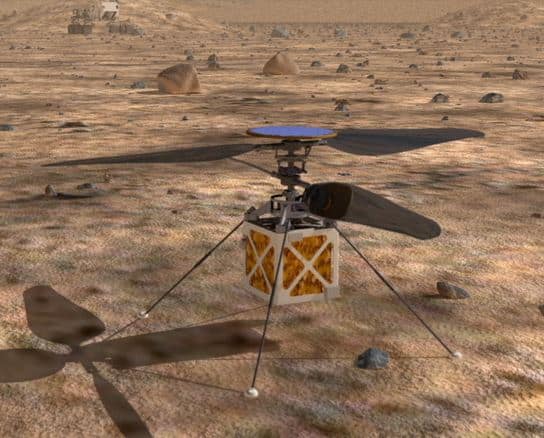NASA believes a helicopter drone flying around as a scout for the ground-bound rover would help the six-wheeled vehicle work more effectively. According to NASA’s Jet Propulsion Laboratory (JPL), the rover would be able to cover three times its current distance each day with the help of a low-flying companion chopper.
Getting around Mars is no easy business, JPL researchers said. They stressed that the NASA rovers have delivered spectacular photographs and data about the composition and history of the Red Planet.
However, its onboard cameras can only see so far, while images from orbiting spacecraft are the only other clues to where the vehicle should roam.

The 1kg Martian helicopter drone would fly ahead of the rover and seek out interesting places to examine. (Image: NASA’s Jet Propulsion Laboratory)
It would be extremely useful to have a low-flying helicopter drone to help decide where to explore next, they say. A small aircraft flying at just fifty feet, for example, would have a much wider view of its surroundings compared to what is currently visible from the rover cameras.
Some of the terrain on Mars is not ideal for the rover to travel over. To traverse across a gritty canyon is cumbersome and extremely slow for a six-wheeled vehicle. Even NASA’s most recent rover, Curiosity, has had problems. Its wheels have been damaged by the wear and tear the Red Planet’s terrain throws at it. A helicopter drone would have no such problems.
“Enter the Mars Helicopter, a proposed add-on to Mars rovers of the future that could potentially triple the distance these vehicles currently drive in a Martian day, and deliver a new level of visual information for choosing which sites to explore.”
The plan would be for the small helicopter drone to fly ahead of its ground-bound companion nearly on a daily basis, looking out for points of interest, helping NASA engineers on Earth decide on the best driving route.
The drone’s cameras could also take photographs of interesting features for the rover to then go and examine in more detail.
The Curiosity rover has traveled slightly more than 7,100 meters (23,300 feet) on the surface of Mars since July 2013, which works out at about 400 meters (1,310 feet) per month. NASA scientists envisage a tiny helicopter covering about 500 meters (1,640 feet) per day.
NASA says the drone will weigh about 1kg (2.2 lbs) and measure 1.1 meters (3.6 feet) across the diameter of its rotor blades.
NASA’s JPL said:
“The current design is a proof-of-concept technology demonstration that has been tested at NASA’s Jet Propulsion Laboratory, Pasadena, California.”
Conditions on Mars are completely different from those on Earth. Helicopters get their lift by cutting through dense air – Mars’ atmosphere, at just 0.6% of Earth’s mean sea level pressure, is extremely thin. Its gravity is only 38% the gravity of Earth.
Video – Martian Helicopter drone
NASA JPL engineer Mike Meacham talks about the Martian helicopter drone.

